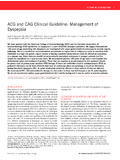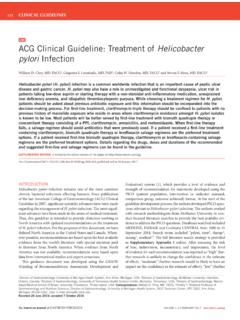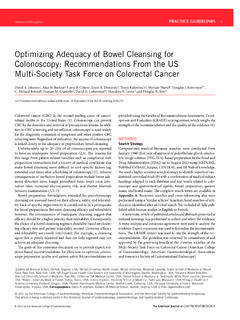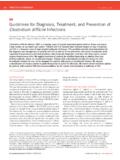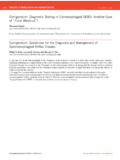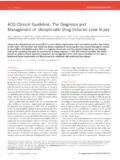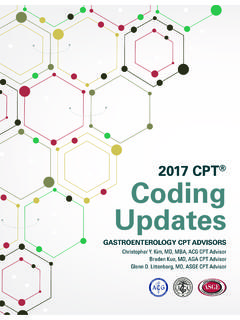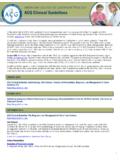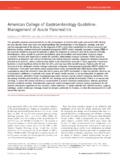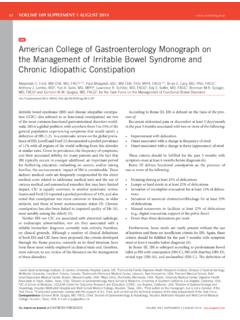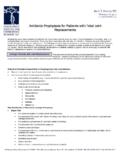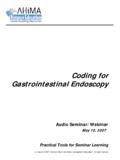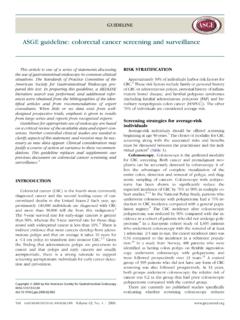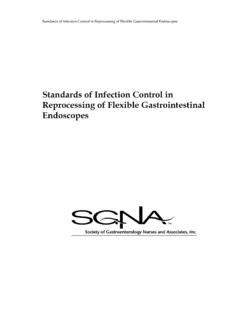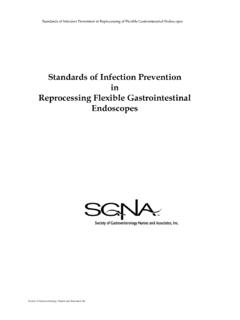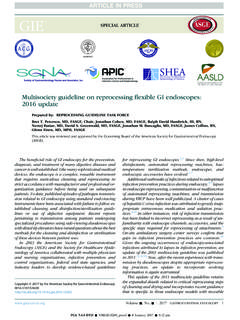Transcription of Preview: Changes to Coding for Lower GI …
1 Preview: Changes to Coding for Lower GI endoscopy procedures in 2015. There are significant Changes to Coding for Lower GI endoscopic procedures ahead in CPT 2015. These Changes follow similar revisions to the upper GI endoscopy codes in CPT 2014 and mark the conclusion of a multiple-year effort to update the terminology of the GI endoscopy codes. This article provides an overview of the Changes to GI Lower endoscopy codes as proposed by the american College of Gastroenterology (ACG), american Gastroenterological Association (AGA), and american society for gastrointestinal endoscopy (ASGE), the american College of Surgeons (ACS), the society of american gastrointestinal Surgeons (SAGES) and the american society of Colon and Rectal Surgeons (ASCRS) to the american Medical Association (AMA)
2 CPT Editorial Panel, the body responsible for maintaining and updating the CPT code set. The information reflects the societies' proposed revisions and subsequent Changes that have been discussed at recent CPT Editorial Panel meetings. A Summary of Panel Actions from each CPT Editorial Panel meeting is available at the AMA's website. The complete 2015 CPT files, containing full code descriptors and instructional information is expected to be released in late August. The Changes will become effective on January 1, 2015.
3 In the 2011 Final Rule, CMS identified a number of endoscopic procedures , including colonoscopy, for review of physician work and practice expense. Section 3134 of the Affordable Care Act gives the Secretary of the Department of Health and Human Services the authority to regularly review Medicare fee schedule rates for physician services to identify potentially misvalued codes, which can include procedures with fast growth, substantial change in practice expense, new technologies or services, multiple codes frequently billed together, codes with low relative values, and Harvard-valued codes.
4 The upper GI endoscopy Changes were implemented last year. As of CPT 2015, the majority of GI endoscopy code families will reflect current terminology and practice. Following approval by the CPT Editorial Panel, the codes were surveyed by the specialty societies, and presented to the AMA/Specialty society Relative Value Update Committee (RUC). While the RUC makes recommendations to CMS, CMS is the only entity that makes relative value decisions regarding physician work, practice expense, and professional liability.
5 General Concepts for all GI endoscopy procedures In recent years, the CPT Editorial Panel has been replacing the terminology with or without in codes throughout the CPT book with including, when performed in an effort to standardize the language and make the code descriptors more accurate. Previously, all GI endoscopy family base codes contained the language diagnostic, with or without collection of specimen(s) by brushing or washing (separate procedure). In CPT 2014. with or without was replaced by including, when performed for esophagoscopy, EGD and ERCP.
6 The same terminology reconciliation will be made to ileoscopy, pouchoscopy, flexible sigmoidoscopy, colonoscopy through stoma and colonoscopy in CPT 2015. This represents an editorial change and does not change the way the codes are reported. Source: american College of Gastroenterology, american Gastroenterological Association and american society for gastrointestinal endoscopy The CPT Editorial Panel has also been replacing bowel with intestine throughout the CPT book. This represents an editorial change and does not change the way the codes are reported.
7 Placement of stent Existing Lower GI endoscopy codes for placement of endoscopic stents include predilation. The new Lower GI. endoscopy codes for placement of endoscopic stents now include pre-dilation, post-dilation and guide wire passage, when performed, consistent with the Changes made to stent placement codes for upper GI endoscopy procedures . Placement of stent should be reported without a reduced services modifier 52 even if all three components (pre-dilation, post-dilation, guide wire passage) are not performed during the same session.
8 Separate reporting of pre-dilation, post-dilation or guide wire passage is not appropriate, as these services are now bundled into the code for the placement of the stent. Control of Bleeding Previous code descriptors for control of bleeding codes included a list of examples such as injection, bipolar cautery, unipolar cautery, laser, heater probe, stapler, and plasma coagulator. The new descriptor for control of bleeding replaces all examples with any method throughout all GI endoscopy families. Do not report submucosal injection if the injection was part of the control of bleeding procedure.
9 New language in the section guidelines clarifies that when bleeding occurs as the result of an endoscopic procedure, control of bleeding is not separately reported during the same operative session. Ablation New codes for ablation procedures now include pre- and post-dilation and guide wire passage, when performed. Separate reporting of pre- or post-dilation or guide wire passage is no longer appropriate, as these services are bundled into the code for ablation. Ablation procedures are not reported with a reduced services modifier 52.
10 When all three components (pre-dilation, post-dilation or guide wire passage) are not performed during the same session. Separate reporting of pre-dilation, post-dilation or guide wire passage is not appropriate, as these services are now bundled into the code for the ablation. Endoscopic Mucosal Resection Endoscopic mucosal resection (EMR) can include injection-assisted, cap-assisted and ligation-assisted techniques. All techniques involve 1) Identification and demarcation of the lesion, 2) Submucosal injection to lift the lesion, and 3) Endoscopic snare resection.
